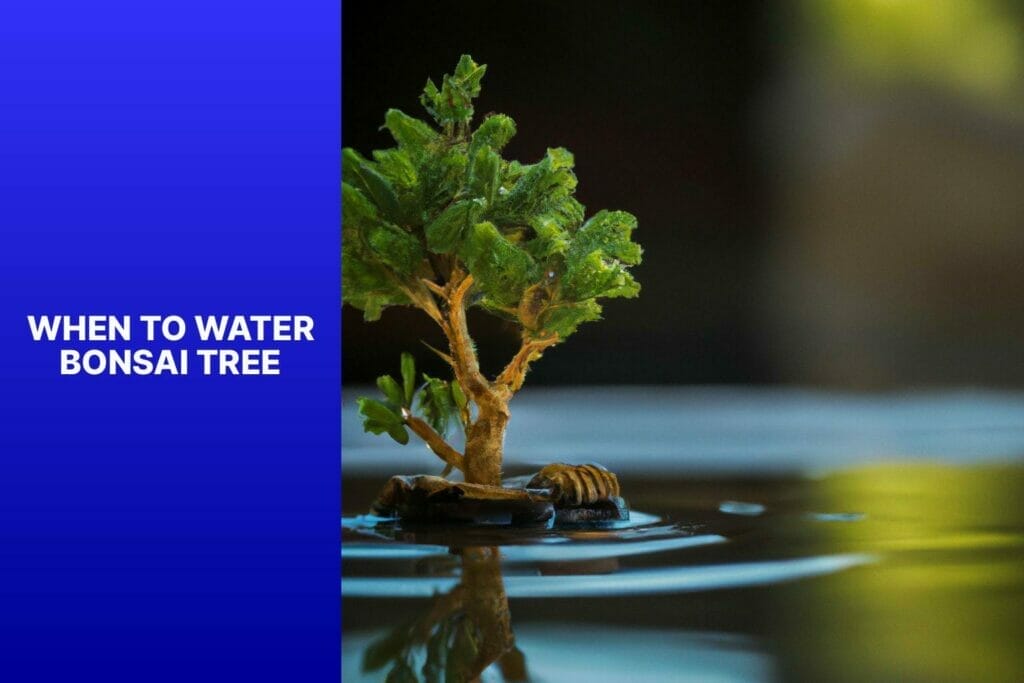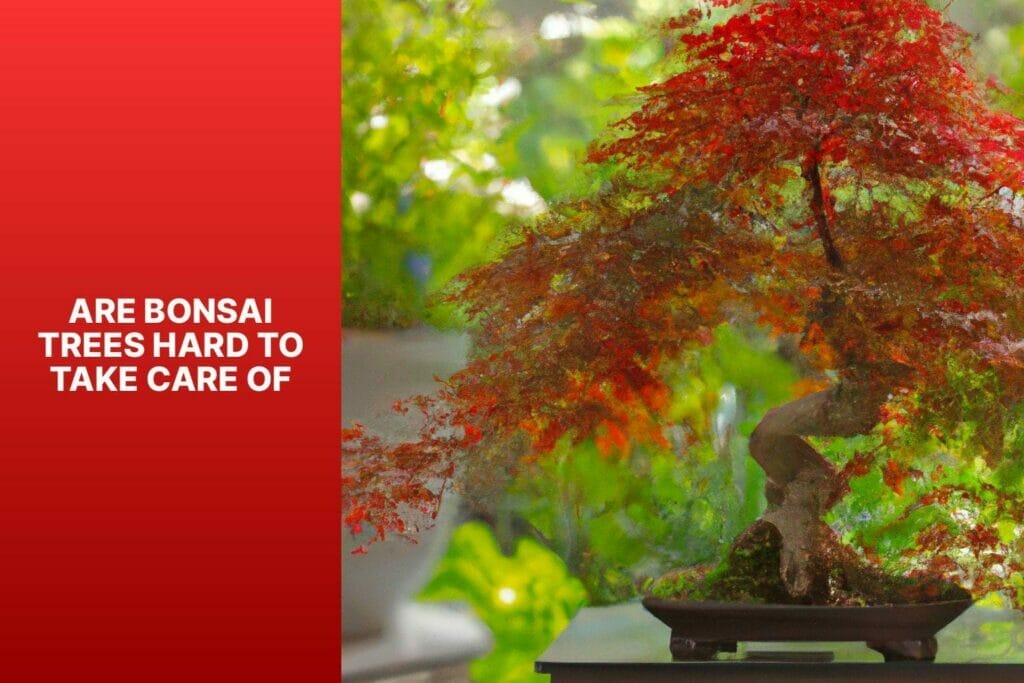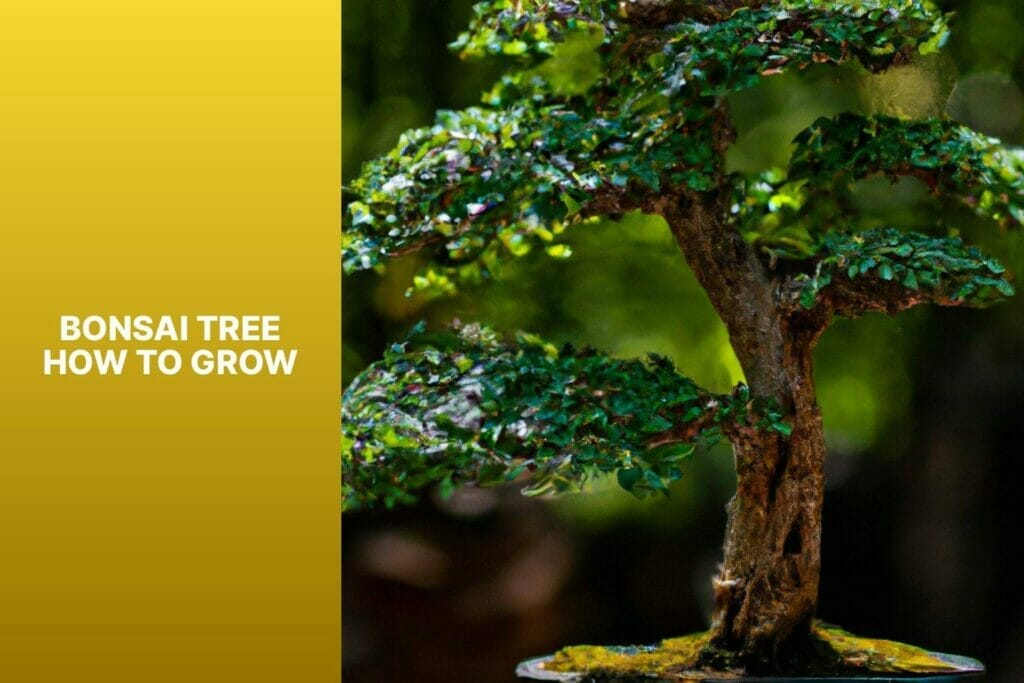Introduction to Watering Bonsai Trees
Watering is a fundamental aspect of bonsai tree care that significantly impacts the tree’s health and growth. Learning the proper watering techniques and understanding the factors influencing watering needs are essential for keeping your bonsai tree thriving.
Why is Watering Important for Bonsai Trees?
Watering is vital in maintaining bonsai trees‘ overall health and survival. Adequate hydration ensures the tree receives the necessary nutrients for growth and development.
It helps regulate the tree’s temperature, supports photosynthesis, and promotes the transportation of nutrients to different parts of the tree. Proper watering also improves root health and prevents drought stress or root rot.
How Does the Watering Technique Affect Bonsai Tree Health?
The watering technique used directly affects the health and well-being of bonsai trees. Improper watering, such as overwatering or underwatering, can lead to root suffocation or dehydration, causing significant damage to the tree.
Finding the right balance and applying the correct watering method is crucial for maintaining the moisture levels necessary for the tree’s growth.
Factors to Consider When Watering Bonsai Trees
Several factors should be considered when determining the watering needs of your bonsai tree:
- Soil Moisture Level: Understanding how to assess soil moisture levels is crucial. The frequency and amount of watering depend on the moisture content of the soil, which can vary based on factors such as humidity, temperature, and the tree’s specific requirements.
- Bonsai Tree Species: Different bonsai tree species have varying water requirements. Some trees prefer moist soil, while others prefer drier conditions. Researching the specific needs of your tree species will help you determine the appropriate watering routine.
- Bonsai Tree Size and Pot Size: The size of the bonsai tree and its pot affects its water retention capabilities. Smaller trees in larger pots retain moisture for longer periods, whereas larger trees in smaller pots may require more frequent watering.
By understanding these factors, you can tailor your watering approach to meet the individual needs of your bonsai tree, promoting its health and longevity.
In the following sections, we will delve deeper into watering techniques, signs of underwatering, and overwatering. We will also provide useful watering tips for different seasons to ensure your bonsai trees thrive under proper hydration.
Key takeaway:
- Proper watering is crucial for the health of bonsai trees: It affects their overall growth, development, and vitality.
- Factors like soil moisture level, bonsai tree species, and size of the tree and pot should be considered when watering bonsai trees to ensure they receive the right amount of water.
- Watering frequency and methods should be adjusted based on the season to accommodate the changing needs of bonsai trees.
Why is Watering Important for Bonsai Trees?
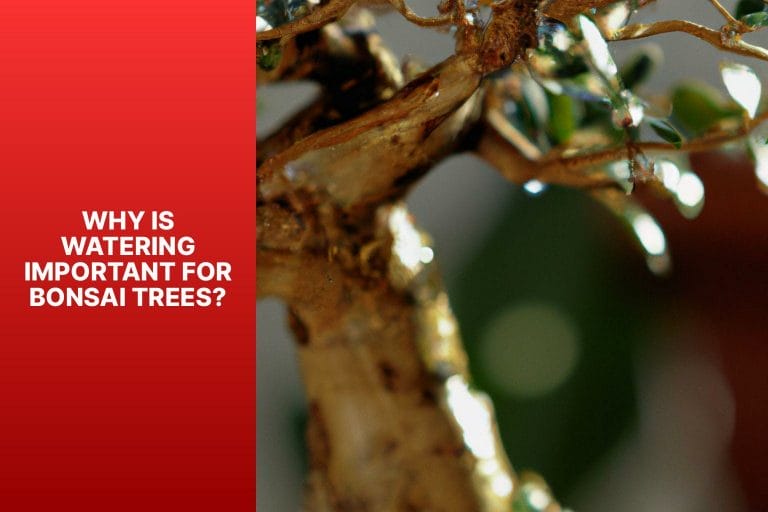
Photo Credits: Mnbonsainetwork.Com by Keith Davis
Watering is vital for bonsai trees’ health and well-being. Here’s why watering is important for bonsai trees:
1. Hydration: Bonsai trees need water to survive. They can dehydrate without proper watering, leading to wilted leaves and stunted growth.
2. Nutrient absorption: Water transports essential nutrients from the soil to the roots of bonsai trees, which is crucial for their overall health and vitality.
3. Temperature regulation: Adequate watering helps regulate root temperature, preventing stress or damage from extreme temperatures.
4. Vigorous growth: Consistent watering promotes strong root system development, leading to healthier foliage and overall growth.
5. Preventing root rot: Proper watering techniques, including good drainage, prevent waterlogged soil and root rot. Excessive moisture can harm bonsai trees and cause root decay.
Consider species needs, climate, and potting medium to ensure optimal watering. Test soil moisture regularly by sticking your finger into it—water thoroughly when the top inch of the soil feels dry.
Adjust watering frequency and amount based on your bonsai tree’s specific requirements.
Remember, overwatering can be as damaging as underwatering. Strive for a balance to keep your bonsai tree thriving.
How Does the Watering Technique Affect Bonsai Tree Health?
The watering technique greatly affects bonsai tree health.
1. Watering frequency: Proper watering ensures adequate moisture for bonsai tree growth. Water consistently, but not excessively, to avoid root rot, oxygen deprivation, dehydration, and nutrient deficiencies.
2. Soil moisture level: Bonsai trees need well-draining soil to prevent waterlogging. Maintain balanced soil moisture- moist but not soggy- to promote effective absorption of water and nutrients by the roots.
3. Watering methods: Choose a method that suits your bonsai tree. Submerge the pot in water, top watering or bottom watering. These methods ensure thorough hydration and support deep-root growth.
4. Bonsai tree species: Different species have different water requirements. Understand your tree’s specific needs for optimal health.
Proper watering is essential for maintaining bonsai tree well-being. Providing the right amount of water at the right time can cultivate thriving trees that enhance your gardening proficiency and boost your enjoyment of this art form. Monitor soil moisture and adjust watering frequency and method accordingly for the best health of your bonsai tree.
Factors to Consider When Watering Bonsai Trees
When it comes to watering bonsai trees, several factors need careful consideration. Each aspect plays a crucial role, from the soil’s moisture level to the bonsai tree’s specific species, as well as the size of the tree and the pot it is planted in.
So, let’s dive in and explore how these factors impact the watering routine for bonsai trees, ensuring their health and vibrancy.
Soil Moisture Level
Maintaining the proper soil moisture level is crucial for caring for bonsai trees. Regularly check the moisture content of the soil to achieve this. The table below illustrates the ideal soil moisture levels for different types of bonsai trees:
| Bonsai Tree Species | Ideal Soil Moisture Level |
| Coniferous Trees (Pine, Juniper, Cypress) | Moist, but not waterlogged. Allow the top layer of soil to dry out slightly before watering. |
| Deciduous Trees (Maple, Oak, Elm) | Keep the soil evenly moist. Avoid letting the soil dry out completely or become overly saturated. |
| Flowering Trees (Cherry, Azalea, Wisteria) | Keep the soil consistently moist. Avoid letting the soil dry out between watering sessions. |
| Tropical Trees (Ficus, Jade, Bougainvillea) | Keep the soil slightly moist. Avoid overwatering, as it can lead to root rot. |
Remember, the ideal soil moisture level may vary slightly depending on factors such as the climate, pot size, and specific needs of the bonsai tree species. Regularly monitor the soil’s moisture level and adjust the watering frequency accordingly.
Pro-tip: To accurately determine the soil moisture level, gently insert your finger about an inch into the soil. It’s time to water the bonsai tree if it feels dry at that depth.
Bonsai Tree Species
Bonsai Tree Species have different characteristics and requirements. The Juniper Bonsai is popular among beginners due to its needle-like foliage. The Pine Bonsai requires more sunlight and moisture compared to other species.
The Maple Bonsai produces beautiful autumn colors and prefers partial shade. The Ficus Bonsai has shiny leaves and can thrive indoors. The Elm Bonsai showcases beautiful serrated leaves and can adapt to various climates.
Each Bonsai Tree Species has specific watering, sunlight, and temperature needs. Understanding these characteristics will help you properly care for your bonsai tree and ensure its health and longevity.
Fact: Proper care and attention can make Bonsai Trees live for hundreds of years.
Bonsai Tree Size and Pot Size
When selecting the size of a bonsai tree and its pot, it is important to consider the Bonsai Tree Size and Pot Size. There are three options for the Bonsai Tree Size: small bonsai tree, medium bonsai tree, and large bonsai tree.
Likewise, there are three choices for the Pot Size: small, medium, and large.
It is crucial to match the size of the bonsai tree with a compatible pot size. A small bonsai tree should be paired with a small pot to provide sufficient root space and prevent excessive growth.
Similarly, a medium bonsai tree requires a medium-sized pot, while a large one needs a large one.
The pot size also plays a significant role in the overall appearance of the bonsai tree. A properly proportioned pot enhances the beauty of the bonsai, whereas a pot that is too small or too large detracts from its charm.
The pot size affects the water retention of the bonsai tree. A smaller pot tends to dry out more quickly, necessitating more frequent watering.
On the other hand, a larger pot may retain excess moisture, which can potentially lead to root rot.
How to Water Bonsai Trees
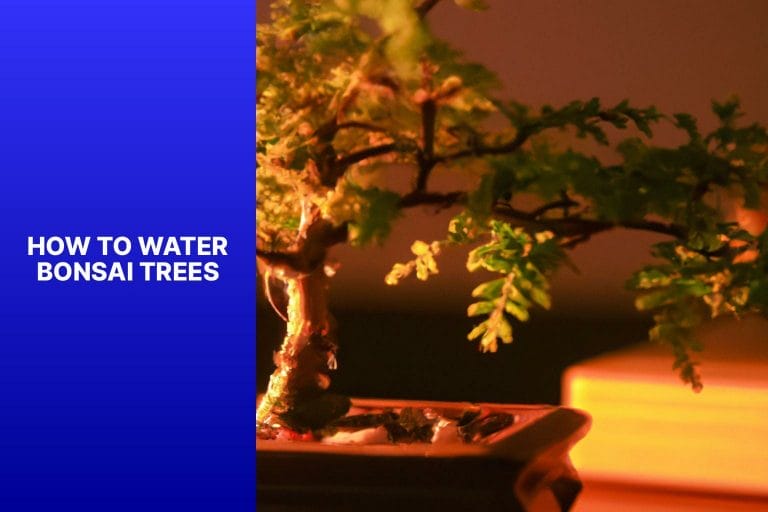
Photo Credits: Mnbonsainetwork.Com by Walter Hall
Ensure the health and vitality of your bonsai trees with proper watering techniques. Discover how to water bonsai trees effectively and optimize their growth. Learn about the ideal watering frequency and explore various methods to keep your bonsai thriving.
Let’s dive into the world of bonsai care and unlock the secrets of providing the right hydration for these delicate living artworks.
Watering Frequency
Finding the right frequency is crucial for their health when watering bonsai trees. Factors to consider are:
- Bonsai tree species: Different species have different water requirements. Some species, like tropical bonsai, may need more frequent watering.
- Soil moisture level: Check the soil moisture regularly by sticking your finger about an inch deep into the soil. If it feels dry at that depth, water the bonsai tree.
- Bonsai tree size and pot size: Smaller bonsai trees and shallower pots dry out more quickly, so they may need more frequent watering.
Guidelines for watering bonsai trees:
- The frequency of watering bonsai trees can vary depending on factors like species, size, and environmental conditions. It is recommended to water bonsai trees when the soil begins to dry out but before it becomes completely dry.
It’s important to note that these are general guidelines, and you should always observe the specific needs of your bonsai tree. Humidity, temperature, and sunlight exposure can also influence the watering frequency.
Regularly monitoring the soil moisture and the overall health of the bonsai tree will help you fine-tune the watering schedule for optimal growth and vitality.
Watering Methods
When it comes to watering bonsai trees, there are several different watering methods that you can employ to ensure proper hydration and promote overall plant health. These methods include submerging, top watering, and bottom watering.
Submerging is a technique where you place the bonsai tree pot in a water-filled container. Doing so allows the soil to absorb moisture through the drainage holes. This method is particularly effective in providing hydration to the roots.
Another method you can use is top watering. This entails pouring water directly onto the soil surface of the bonsai tree until it drains out of the bottom of the pot.
It is important to distribute the water evenly to ensure that all roots receive the necessary hydration.
On the other hand, bottom watering involves placing the pot on a tray filled with water. This allows the soil to absorb moisture through the drainage holes. Bottom watering is particularly suitable for bonsai trees with shallow roots.
It is important to note that each watering method has advantages and limitations. Therefore, choosing the method that best suits both your bonsai tree’s specific needs and your watering schedule is essential.
It is crucial to regularly monitor the soil’s moisture levels to prevent overwatering or underwatering your bonsai trees.
Signs of Underwatering and Overwatering
Signs of underwatering and overwatering in a bonsai tree can harm its health and growth. It is important to identify these signs and take appropriate action.
– Signs of underwatering:
– Wilted or drooping leaves
– Yellow or brown leaves that easily fall off
– Dry, brittle soil pulling away from the pot’s edges
– Slow growth or stunted development
– Signs of overwatering:
– Yellowing leaves that are soft and mushy to the touch
– Mold or fungus growth on the soil surface
– A sour or musty smell coming from the soil
– Root rot or blackened roots
A true story illustrates the importance of proper watering. I once overwatered a bonsai tree unknowingly.
The leaves turned yellow, fell off, and a foul smell arose from the soil. I stopped watering and let the soil dry out.
Eventually, new healthy leaves grew, and the tree regained vitality. This experience taught me the significance of recognizing signs of overwatering and adjusting watering practices accordingly.
Watering Tips for Different Seasons
Discover the essential watering tips for different seasons when caring for your bonsai tree. Each season requires a unique watering approach from spring to winter to ensure your bonsai’s health and vitality.
Learn how to properly water your bonsai tree in spring, summer, fall, and winter to provide the ideal moisture levels for its growth and development. No more guessing about watering your precious bonsai – we’ve covered you with these seasonal watering techniques.
Watering Bonsai Trees in Spring
When watering bonsai trees in spring, it is important to follow these steps to ensure proper care. First, check the soil moisture level by inserting your finger. It is time to water the tree if it feels dry up to your second knuckle.
Next, thoroughly water the bonsai tree, draining water from the bottom drainage holes. This will ensure that the roots receive adequate moisture throughout the pot.
After watering, allowing excess water to drain completely is crucial before placing the bonsai tree back in its designated spot. This will prevent waterlogged soil and potential root rot.
Bonsai trees may require more frequent watering in spring due to warmer temperatures and increased daylight hours, leading to faster evaporation.
It is important to adjust the watering frequency accordingly to avoid underwatering or overwatering and maintain the bonsai tree’s health and vitality.
Watering Bonsai Trees in Summer
When watering bonsai trees in summer, keep these steps in mind:
- Regularly check soil moisture to determine when watering is needed. Bonsai trees need more water in the hot summer months.
- Thoroughly water the bonsai tree until water flows from the bottom drainage holes. This hydrates the entire root system.
- Avoid overwatering, as excess moisture can cause root rot and fungal diseases—only water when the soil is slightly dry to the touch.
- Consider the watering needs of the specific bonsai tree species. Some species require more water than others during the summer. Research their specific requirements.
- Provide shade or protect the bonsai tree from direct sunlight during the hottest parts of the day to prevent excessive evaporation and dehydration.
- Use a moisture meter to measure soil moisture and accurately determine when watering is necessary. This prevents under or overwatering and ensures the right amount of moisture for the tree.
Following these steps promotes the health and vitality of your bonsai tree during the summer months.
Watering Bonsai Trees in Fall
When watering bonsai trees in the fall, it is important to follow these steps for their health and vitality. Start by checking the soil moisture by inserting a finger about an inch into the soil.
If it feels dry, water the tree thoroughly until water drains from the bottom of the pot, ensuring water reaches all parts of the root system.
Allowing the soil to dry slightly between waterings is crucial to avoid overwatering. This prevents root rot and excessive moisture issues.
Consider the specific bonsai tree species when determining watering frequency. Some species may require more frequent watering, while others prefer slightly drier conditions.
Take into account the size of the bonsai tree and pot. Larger trees and pots may need more water than smaller ones. Observe the weather conditions, as temperature and humidity changes in fall can affect the water needs of your bonsai tree.
Adjusting the watering frequency accordingly to balance hydration and prevent waterlogged roots is crucial.
Bonsai trees, originally from China, have a rich history spanning over a thousand years. The art of bonsai involves cultivating miniature trees in pots and creating living sculptures that embody harmony and tranquility.
Watering bonsai trees is crucial, especially in the fall when the weather cools and trees prepare for dormancy. By providing proper hydration and considering each tree’s specific needs, enthusiasts can enjoy the beauty and serenity of their miniature creations for years to come.
Watering Bonsai Trees in Winter
When it comes to watering bonsai trees in winter, there are certain factors you need to consider to ensure their health and well-being.
- To begin with, it is important to reduce the watering frequency during winter since bonsai trees are dormant. Allowing the soil to dry slightly between waterings is crucial to avoid overwatering.
- Another effective method to consider is the “bottom watering” technique. Placing the pot in a water tray allows the roots to absorb moisture. This approach helps prevent excessive moisture on the foliage, which can lead to fungal diseases.
- Before you water your bonsai tree, always check the soil’s moisture level. This can be done by checking the soil one inch deep. Only proceed with watering if the soil is dry to prevent waterlogging the roots.
- In regions where freezing temperatures are a concern, it is vital to protect the bonsai trees. This can be achieved by moving them to a sheltered location or insulating the pots to shield the roots from potential damage.
During the last winter season, I had the pleasure of nurturing a beautiful bonsai tree in my garden. To ensure its survival, I diligently followed the guidelines for watering bonsai trees in winter.
By reducing the watering frequency, implementing the bottom watering method, regularly checking the soil moisture, and protecting the tree from freezing, I witnessed my bonsai tree thriving and remaining healthy throughout the winter.
Some Facts About When To Water Bonsai Tree:
- ✅ Watering a bonsai tree can be challenging as there is no set schedule. It depends on soil moisture, container size, and ambient temperatures.
- ✅ Checking the soil dampness about a centimeter below the surface is a good way to determine if a bonsai tree needs watering.
- ✅ Overwatering is a common cause of death in bonsai trees as their roots cannot dry out or remain waterlogged.
- ✅ The top layer of soil should feel dry and appear loose and grayish when it’s time to water a bonsai tree.
- ✅ Rainwater is preferred over tap water as it lacks chemicals and mimics the natural environment for bonsai trees.
